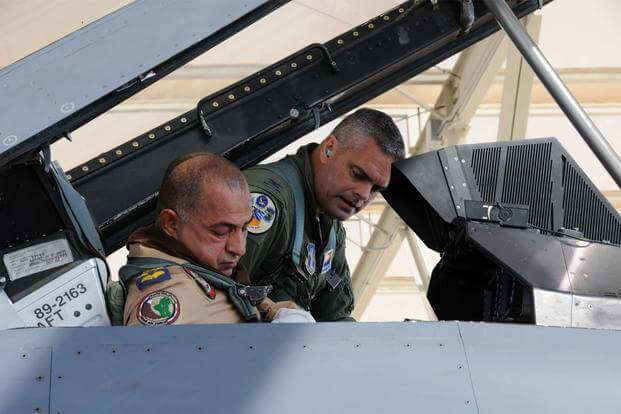The Air Force is working closely with the Pentagon and State Department to try to ensure Iraqi fighter pilots training in the U.S. can obtain exemptions under President Donald Trump's executive order to curtail immigration from certain Middle Eastern countries, according to an official.
There are approximately 30 Iraqi pilots currently training to fly the F-16 Fighting Falcon with the Air National Guard's 162nd Wing at Tucson International Airport, Air Force spokesman Col. Patrick Ryder told reporters Tuesday.
"The Iraqi military is obviously a very close partner … in the fight against [the Islamic State]," Ryder said at the Pentagon.
He said officials are in discussions to ensure "those pilots can get to their training in Arizona."
"We'll continue to work very hard to try to make that happen, and I'm confident that we will," Ryder said. "We're fighting in Iraq, helping the Iraqis fight, and so it just makes sense to be able to try to ensure that they get the training they need.
"Since the beginning of this fight [against ISIS], we've had pilots coming in and out [of the U.S.] and it's critical training," he said, noting the number of pilots per training group fluctuates depending on the training mission.
The 162nd has trained pilots from the Netherlands, Norway, Singapore, Japan, Turkey and Israel, among other countries. In 2014, for the first time, Iraqi pilots began training on their own F-16s at Tuscon after Iraq purchased 36 aircraft in 2011.
Afghanistan Not on the List
Notably missing from Trump's executive order -- a temporary ban preventing immigrants or refugees from Iraq, Iran, Syria, Yemen, Sudan, Libya and Somalia from traveling to the U.S. -- is Afghanistan, where the U.S. has conducted military operations for more than 15 years, and where aerial operations are on an upward trend.
Last year, the U.S. Air Force -- under Operation Freedom's Sentinel, the Pentagon's name for missions after the transition from Operation Enduring Freedom -- conducted 1,337 airstrikes against Taliban, al-Qaida and Islamic State militants throughout Afghanistan. Just one month into 2016, the Air Force unleashed the most airstrikes since 2013, according to Air Force Central Command statistics.
RELATED: Taliban's deadly onslaught across Afghan provinces draws increased U.S. air power
The service relies heavily on aircraft such as F-16s and drones such as the MQ-1 Predator to conduct strikes, but the area of responsibility has more than 750 aircraft at its disposal to "fight the enemy," AFCENT spokesman Maj. Omar Villarreal told Air Force Times last May.
Stateside, the Air Force is also responsible for training Afghan pilots. The service last year delivered four A-29 close-air-support aircraft to Afghanistan in January -- one month after the first Afghan pilots and crew for the attack plane completed training at Moody Air Force Base, Georgia.
The program, which began in 2015, will ultimately train 30 pilots and 90 maintainers through 2018 at the base, according to the Air Force.
Ryder said it is too soon to say if or how potential exemption orders from the White House may affect the program.
"Afghanistan is not on that list at the moment," he said, "[but] there's always a robust dialogue that's going on with our partners around the world to try to make sure that, when we do have training programs, that we can get the folks in and out of the country."
Then-Secretary of the Air Force Deborah Lee James said earlier this month that while the Air Force mission in Afghanistan continues, political discussions between U.S. and Afghan counterparts will be key.
"Unlike the fight against [the Islamic State] where there is steady progress, Afghanistan is much more of a standoff," James told Military.com.
"We make gains, the [Taliban or ISIS] makes gains. It goes back and forth. It comes back to the importance of political solutions. Somehow, there is a military solution to [ISIS] to then be followed by political solutions. But when it comes to Afghanistan, my sense is, the political is even more important," she said in an interview at the Pentagon.
It is unclear how the Trump administration intends to continue the dialogue as terrorist attacks have claimed hundreds of civilian lives across Afghanistan in recent years -- with no obvious signs of subsiding.
Earlier this month, the Taliban claimed responsibility for a double bombing near the Afghan Parliament office compound in Kabul, killing dozens. A second bombing Jan. 10 hit a government guesthouse in the southern province of Kandahar, The New York Times reported, injuring more than 80.
Ongoing Mission
The U.S. military services have an ongoing train, advise and assist mission in Afghanistan.
More than 300 Marines will deploy to Helmand this spring as advisers and trainers for the Afghan National Army and police, Marine Corps officials announced this month.
The deployment comes at the request of U.S. Central Command and U.S. Forces Afghanistan in support of the ongoing NATO-led Resolute Support mission, which began after most combat forces pulled out at the end of 2014.
Even with the drawdown, the U.S. Army maintains a visible presence in Afghanistan at various population centers such as Kandahar.
President Barack Obama last year announced the U.S. would maintain at least 8,400 troops in Afghanistan. He originally had planned to reduce the military's footprint of 9,800 to 5,500 before his term was up.
Last month, Army Gen. Joseph Votel praised Obama's decision to keep more troops as a "wise move."
"I think it sent a very strong message to the coalition," the commander of U.S. Central Command said. "I certainly think it sent a strong message to the Afghan forces and the people of Afghanistan ... so I am very keen to keep that going into the future."
-- Oriana Pawlyk can be reached at oriana.pawlyk@military.com. Follow her on Twitter at @Oriana0214.






























